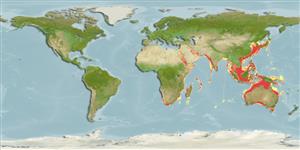Common names from other countries
Environment: milieu / climate zone / depth range / distribution range
Ecologia
Oceanódromo (Ref. 75906); intervalo de profundidade 0 - 2000 m, usually 1 - 50 m. Tropical; 90°N - 90°S, 15°E - 180°E
Indian Ocean and Western Pacific Ocean.
Length at first maturity / Tamanho / Peso / Idade
Maturity: Lm ?, range 208 - 220 cm Max length : 270 cm BL macho/indeterminado; (Ref. 104989); Peso máx. publicado: 230.0 kg (Ref. 104988)
They prefer living on seagrass meadows and rocky substrata (Ref. 114971). Feeds on bony fishes and cephalopods (Ref. 84677). Attacked and preyed upon by tiger sharks Galeocerdo cuvier (Ref. 104930). This species was reported to display complex prey handling of the benthic-dwelling Maori octopus (Macroctopus maorum), processing its prey by shaking and tossing (Ref. 122728). The same octopus was reported to have asphyxiated an adult male of this species, with the octopus arms protruding from the mouth and the rest of the body blocking the pharynx, larynx and
esophagus (Ref. 122729). Occurs in pods of various numbers (Ref. 129713).
Rice, D.W. 1998. (Ref. 1522)
Categoria na Lista Vermelha da IUCN (Ref. 130435)
Categoria CITES (Ref. 108899)
Utilização humana
Pescarias: espécies comerciais; isco: usually
FAO - pescarias: landings | FishSource | Sea Around Us
Ferramentas
Mais informação
Idade/TamanhoCrescimentoComprimento-pesoComprimento-comprimentoMorfologiaLarvasAbundância
Fontes da internet
Estimates based on models
Preferred temperature
(Ref.
115969): 21.9 - 29, mean 27.6 (based on 2288 cells).
Categoria de preço
Unknown.
